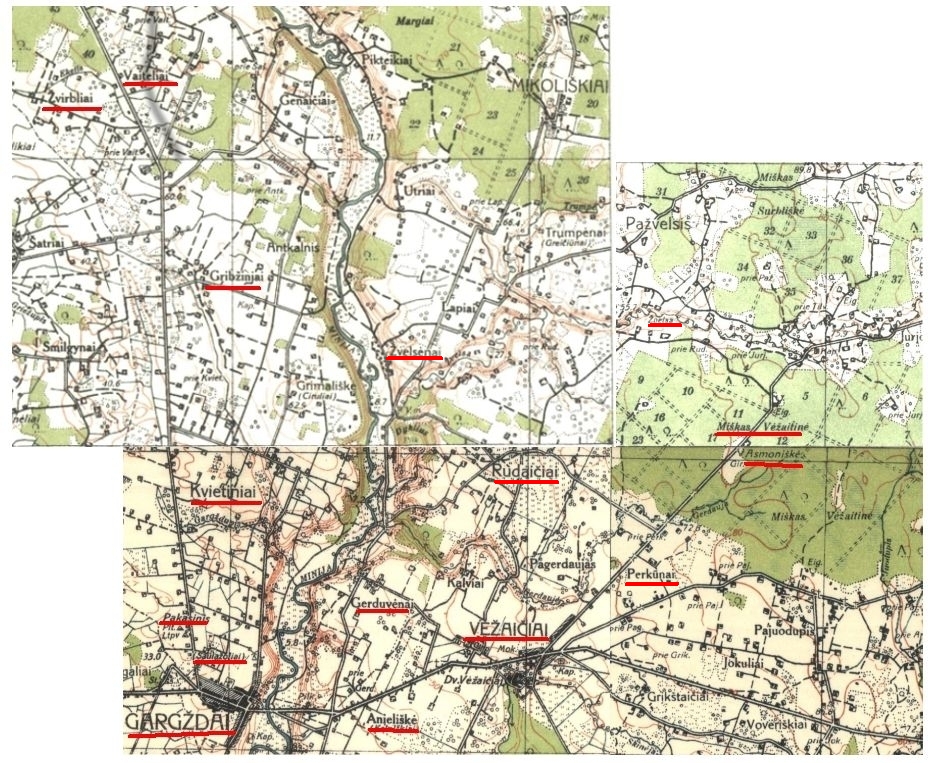

The following documents in the Lithuanian Special Archives are identified by Dr. Arunas Bubnys, Holocaust in Lithuanian Province in 1941 at 40-43 as sources of information regarding the killing of the Jewish women and children of Gargzdai:
Translations of these Russian language documents are set forth below.
Translations by Valentina Aleksa
Tr
Translator’s note: Words which are
illegible or not visible are set forth in brackets as follows: [ ].
Place names of smaller towns and villages are generally set forth as
named in the document, rather than according to their Lithuanian
names.
E Editor's Note: Editor's redactions from the document are set forth in braces as follows: {}
Translation
by Valentina Aleska
Translator's Note: The name "Puzneckis" is set forth below according
to its Lithuanian spelling, rather than as transliterated in the
Russian document.
I. Interrogation minutes of A. Puzneckis
26 October 1944, LSA, doc.col. K-1, inv.sched. 58, file 38501/3:
USSR
People’s Commissariat of State Security
Seal – “Acquired in 1962”
Kretinga District Department of NKGB of Lithuanian Soviet Socialist Republic [Illegible note across]
Seal – “Lithuanian SSR KGB archive”
File # 1363
{Name 1 and} Puzneckis Antanas Ionas1 are charged in accordance with Article 58-1a.
|
Case opened: November 10, 1944. Case closed: December 25, 1944. |
Number of volumes: 1 Volume # 1 |
|
After trial and entry of judgment into force, this file must be returned immediately to [Criminal Archive?] of NKGB.2 A copy of judgment must be attached to the file. |
Transfer of files which are being processed, as well as files taken from archive to other departments and agencies of NKGB, even temporarily, is conducted exclusively through _______________________ (name of inventory department) Transfer of investigation file is processed with permission of Chief of corresponding NKGB office or his/her Deputy.
|
|
Justification: Directive of NKVD, Prosecutor’s Office, and People’s Commissariat of Justice of the USSR # 00359 of 10/IV/1939 (April 10, 1939).
|
|
|
Archive
# 38501/3 Submitted to archive on ______ 194____
|
Page 1
Record of interrogation pertaining to Case #19.
Interrogation started on October 26, 1944, at 11:40.
Finished on ______________, 194_, at 22:00.
I, investigator of NKGB task force of the Lithuanian SSR, second lieutenant {L}, interrogated a suspect under arrest:
1. Last name, name, and patronymic Puzneckis Antanas Ionas;
2. Born in 1914;
3. Place of birth: village Pakasiny3, Gargzdai district;
4. Address: village Soviazhsin4, Gargzdai district;
5. Member of any party: not a member;
6. Nationality: Lithuanian
7. Citizenship: USSR;
8. Passport or other documents: Passport series I-?? # 589130 (passport number, series number, when and by whom was issued);
9. Education: literate, village school (when and where went to school; place of graduation);
10 Occupation and specialization: agriculture;
11 Type of work performed: laborer (place of work, position);
12 Marital status: married (degree of relationship, last names, names, patronymics, addresses, occupations);
13 Social class background: “middle-class” peasant;
14 Social and political activity in the past ____________________ ;
15 Government awards: none;
16 Military or special rank: none;
17 Military obligation: liable for military service;
18 Participation in the Great Patriotic War: did not participate;
19 Battle injuries or shell-shocks: none;
20 Lived on the territory occupied by the enemy? Lived on the occupied territory from 1941 until the day of liberation; was a member of the “white Army” bandit group;
Page 2
(Pencil mark – 19)
Testimony
of the defendant (witness) Puzneckis Antanas Ionas
Question: How many times did you participate in execution by firing squad of Soviet citizens?
Response: I participated in execution by firing squad of Soviet citizens twice. The first execution of Soviet citizens occurred at the end of September, 1941, in the forest, near the village Ashmonishki,5 Gargzdai district, Kretinga parish, Lithuanian Soviet Socialist Republic. I talked about my participation in this execution and all the details of this execution during the interrogation on October 25, 1944.6 As for the second mass execution of Soviet citizens, I can report the following. After the execution of the first group of the defenseless Soviet women in the forest, near the village Ashmonishki, all of us returned to Gargzdai police department, where the police Chief told everybody, who participated in the execution of the Soviet citizens, to report to the police department the next morning. All of us, who participated in the executions of the Soviet citizens on the first day, reported to the police department, as we were told. Moreover, new people were involved on the second day. The Chief of the Gargzdai police department ordered all participating citizens, as well as police officers, to go to the Anelishki’s7 estate. The police officers prepared one horse cart, which was loaded with rifles and munitions, and we went to the Anelishki estate, which was located, approximately, one kilometer away from Gargzdai. We were in groups of…
Signature: Puzneckis
Page 3
Testimony of the defendant (witness) continued (Red pencil mark “20”)
… 2 or 3. We came to the Anelishki estate on foot. Personally, I walked with the citizen {I}, who lived in Gargzdai. When we came to the (village) Anelishki estate, about 16-17 horse carts were already there, ready to go. The Chief of the Gargzdai police, Manchkus8, ordered to put the Soviet citizens, who were held in the camp in the Anelishki estate, on the horse carts. After placing the Soviet citizens on the carts, the Chief of the police assigned all police officers evenly among the carts to guard those who were sitting on them. There were only 3 or 4 police officers who were assigned to every fifth cart. I, as well as other citizens, was involved as a security guard and was on one of the carts, where there were no police officers. The Chief of the Gargzdai police, Manchkus, along with other four police officers, left on the cart loaded with rifles and munitions. Sometime later, at about 11:00 am, after getting all the guards on the carts, we all headed towards Ashmonishki.
Question: How many Soviet citizens were there on each cart?
Response: The carts differed in size, so there were 5-6 Soviet citizens on some of them, but the large ones took up to 12 persons.
Question: Continue your testimony.
Response:
Signature: Puzneckis
Page 4
(Pencil note – 20 [?])
On the way to the village Ashmonishki, approximately, one kilometer before getting to the village, the convoy made a right turn towards the forest. Right there, the Chief of the police with other police officers, who left earlier from the Anelishki estate, were waiting for us to provide more security for traveling through the forest. When the carts were going through the woods, the Soviet citizens, among whom there were defenseless women and children (and some women had babies) started to scream and cry, because the Soviet citizens understood that they were going to be executed. After having traveled by the forest road for about half a kilometer, all the carts stopped near the forest meadow.9 One grave was dug in that meadow: approximately, 10 meters long, 3.5 meters wide. I don’t know how deep it was, because I did not approach the grave. The grave was fenced by a barbed wire, approximately, 25-30 meters in diameter. When we arrived to the location of the execution of the Soviet citizens, there was a Roman Catholic priest10 there, in the space surrounded by the barbed wire. I don’t know his last name, but I know that he lived and served in the church in Vezaiciai, All the Soviet citizens were huddled in the place surrounded by the barbed wire. The Chief of the police ordered us to stand around the barbed wire to prevent any escape attempts, so we did.
Signature: Puzneckis
Page 5(Red pencil note– 21)
After that, the Chief of the police, Manchkus, ordered the police officers {I}, {S}, Salikla Bronius11, Lukauskas Ildefonas12 (I do not know the last names of the others, but there were 7 or 8 persons in total), to take the defenseless Soviet women and children to the grave and conduct execution.
Before the execution, as well as during it, there was a continuous and endless moaning and crying of the Soviet women and children. At that time, when the execution was in process, the Chief of police Manchkus said that “whoever wanted to become a Catholic, could come to the Roman Catholic priest and receive communion.” After that the women asked if they would stay alive, if they received communion. Manchkus responded: “Even if you receive communion, you still will be executed.” After that reply, some women went to the priest to receive communion, but were still executed. The majority of women did not go to the priest. When the execution of defenseless women and children was over, the Chief of the police ordered all the guards to take shovels and start throwing dirt into the grave. I participated in throwing dirt into the grave, where there were dead bodies of the Soviet citizens.
Signature: Puzneckis
Page 6
I have to mention that we did not put a lot of earth into the grave, because the Chief of police Manchkus hurried us to go to Gargzdai. Meanwhile, when we were shoveling earth into the grave, the police officers, who conducted the execution of the Soviet citizens, gathered all their clothes and put them into the carts, and then everybody left, except myself and {B}, who lived in the village Kvietiniai and had his own cart. We went straight home, because my village is on the way to the village Kvietiniai.
Question: Were there any cases of burying Soviet citizens who were still alive?
Response: I cannot provide any facts on this. When we were throwing earth into the grave, filled with the executed Soviet citizens, nobody demonstrated any signs of being alive; they were quiet, but, based on the stories of people who lived in the village Ashmonishki (I don’t know exactly who was telling those stories), during the first night after the execution of the Soviet citizens, there was moaning coming from the place of the execution. This might be possible, because we did not have enough time to put enough earth on top of the executed Soviet citizens – we put no more than 25 centimeters…
Signature: Puzneckis
Page 7 (Red pencil mark – 22)
… and even less than 25 centimeters in some places.13
Question: Were there any other incidents of executions of Soviet citizens in the Gargzdai district?
Response: From the conversation with the villagers (I don’t remember now who they were), I know that there was one more incident of execution of Soviet citizens in the Gargzdai district, not far away from Gargzdai, in the direction toward the Memel (Klaipeda) border, where male Soviet citizens were executed. This was, approximately, on the third day since the beginning of the war, around June 25, 1941. But I do not know who participated in this execution.
Question: So, you participated in the execution of the Soviet citizens two times?
Response: Yes, two times.
Question: How many defenseless Soviet citizens were killed by you personally or with your assistance?
Response: Personally, I shot 4 Soviet women. I spoke about it in detail during the interrogation which occurred on October 25, 1944. But I assisted in execution of, approximately, 270 Soviet women and children.
Question: Name all persons you know, who participated directly or indirectly in executions of Soviet citizens at the end of September, 1941 …
Signature: Puzneckis
Page 8
(Pencil mark – 22 [?])
… in the forest, near the village Ashmonishki, the first time and the second time. Where are they now?
Response: I know the following participants, who participated in the first and in the second execution of Soviet citizens, which were conducted at the end of September, 1941, in the forest, near the village Ashmonishki, Gargzdai district, Kretinga parish, Lituanian SSR:
1. 1. {I} – a resident of Gargzdai; worked as a police officer, personally executed the Soviet citizens in the first and in the second shooting. Sometime later, after the execution of the Soviet citizens, he volunteered to join the German army. I don’t know where he is now. His family also left and I do not know where to.
2. 2. {S} – I don’t know his first name, a resident of the village Vezaiciai. Worked as a police officer, personally participated in the executions both times. Approximately, in October, 1941, he moved from Gargzdai to start a new job elsewhere, but I do not know where.
3. 3. Salikla Bronius – a resident of Gargzdai, worked as a police officer until the arrival of the Red Army. During both executions, he personally shot Soviet citizens.
Puzneckis
He ran away with the German army during retreat.
4. 4. {G1} – a resident of the village Anelishki, participated in transporting and guarding Soviet citizens, who were going to be executed. At the present time, he lives in the same village Anelishki.
5. 5. Manchkus – the Chief of the Gargzdai police; worked there before the arrival of the Red Army. I don’t know exactly where he is now, but I know that he has a property on the way to the town of Veivirzenai.
6. 6. Gubista14 – I don’t know his first name. A resident of the village Gerduvenai. Both times assisted in transportation of the Soviet citizens to the location of execution using his own horses. Currently, he lives in the above-mentioned village.
7. 7. {B}, a resident of the village Kvietiniai. He was also taking Soviet citizens to the location of the execution both times. Currently, lives in the same village.
8. 8. {P1} – a resident of the village Anelishki, who participated in transportation of Soviet citizens to the execution location during the second shooting. At the present time, he lives in the village Anelishki and works on his farm.
9. 9. {P2}, a resident of the village Anelishki, who participated in transporting Soviet citizens to the execution location during the second shooting.
Puzneckis
Page 10
(Pencil mark – 23)
Before the retreat of the German army from the Kretinga parish, {P2} worked as a laborer in the village Kvieitiniai for the landlord whose last name is {G}. During the retreat of the German army, he was taken to Germany by the Germans.
1 10. {L1} (I don’t know his first name), along with his brother, the residents of the village Vaitelu15 participated in the second execution by escorting Soviet citizens to the location of execution. I am not sure where they are right now. Probably, still living at home.
11 11. { L2} – I don’t know his first name. He is a resident of the village Zevirbliu16. He escorted the Soviet citizens to the location of execution during the second shooting. I don’t know where he lives now. I can add the following about {L2}: the husband of {L2}’s sister, whose name is {Y}, a resident of the village Gribusinei17, told me once, sometime in October, 1941, when we were at the mill house, that, during the Soviet rule in Lithuania in 1940-1941, {L2}went across the state border from Lithuanian SSR to Germany with some military information, but I don’t know exactly what kind of information it was and where he obtained it.
Some other people also participated in the execution of the Soviet citizens, but I do not know their last names.
Puzneckis
Page 11
Question: How did you participate in looting of personal possessions which belonged to the Soviet citizens, who were executed?
Response: I brought a short fur coat from the location of the first execution. This coat belonged to the Soviet woman who was executed. I do not know her last name. The rest of the belongings was collected by the police officers. They took personal belongings to the police warehouse in Gargzdai, from where, sometime later, the Red Cross distributed all the belongings among poor local residents. I received something too: one featherbed and two feather pillows, and nothing more.
Question: What kind of personal property did {S- see page 8, # 2}acquire by taking it from the Soviet citizens?
Response: I cannot say anything about this.
Question: What other assignments did you receive from the German authorities?
Response: I did not receive any other assignments from any German authorities.
Puzneckis
Page 12
(Pencil mark – 24)
I am telling the truth in this regard.
Puzneckis
The record of interrogation was read to me in the language that was understandable to me (Lithuanian). My responses were written correctly.
Puzneckis
Interrogators: Investigator of NKGB task force of the Lithuanian SSR, second lieutenant {L}.
Special agent of NKGB task force of the Lithuanian SSR, second lieutenant, {B}.
Concluding
Pages:
(Illegible note in pencil – “No info, signature”?)
Form – n - 2
Sentence
In the name of the Union of Soviet Socialist Republics
The 19th of March, 1945. The city of Šiauliai.
Military
Tribunal of NKVD (People’s Commissariat of Internal Affairs) Forces of
the Lithuanian Soviet Socialist Republic, in open court hearing/closed
judicial session
[?] Office of Special Department of NKVD
Chief Justice: Captain {B} (Ministry of Justice)
[?] First Sergeant {S}
[?] Private {L}
Secretary: First Lieutenant {M} (investigator assistant)
[?] sides: prosecution and defense
After hearing the case of the defendant Puzneckis, Antanas, the son of Ionas, born in 1914, in the village of Pakasiny, Gargzdai district, Kretinga parish, the Lithuanian Soviet Socialist Republic, a peasant, of a peasant decent, Lithuanian, not a member of the Communist Party, 2 years of school education, not married, [did not serve] in the Red Army, no relatives, with no criminal record, who was charged with a crime in violation of Article 58-1a of the Criminal Code of the Russian Federation
the court determined the following:
The defendant Puzneckis, while living on the territory temporarily occupied by the German forces, participated in mass executions by firing squad of Jewish population in September 1941 twice. As an accomplice in the above-mentioned executions, Puzneckis convoyed the Jewish people to the location of executions twice: …
… about 70 people on the first day and about 300 people on the second day.18. After executions, Puzneckis buried the bodies of the executed, placed their clothes, which were taken off before the executions, on the carts and took the clothes to the police department. All the above taken into account, a military tribunal found Puzneckis guilty of committing a crime in violation of Article 58-1a and part 2 of the Decree of the Supreme Soviet of the USSR of April 19, 1943.
In accordance with the articles 319-320 of the Criminal Procedure Code
the Tribunal sentenced
Puzneckis Antanas, the son of Ionas, based on the Article 58-1a of the Criminal Code of the Russian Federation and with authorization of part 2 of the Decree of the Supreme Soviet of the USSR of April 19, 1943, to penal labor for 20 years with a subsequent deprivation of rights for 5 years, according to parts a, b, c, d of the Article 31 of the Criminal Code of the Russian Federation, and confiscation of all personal property. Incarceration term for the convicted Puzneckis, in accordance with the Article 29 of the Criminal Code of the Russian Federation [is to be counted – inserted] starting on October 25, 1944. This sentence is final and not subject to any appeal.
Consider the above-written insertion “is to be counted” true and correct.
Chief Justice {B}
[ ] {L}, signature
Seal
Measures taken in regard to repressions against family members
in accordance with guidelines of NKVD USSR and Public Prosecution Office of the USSR
##215/5c from 30.V 252, from 27.VI 1942.
[ ] ##61990
Chief of the department “A” of NKVD USSR
Special agent – signature.
1.
The
name of the Defendant has two spellings in these documents: "Gubista"
and "Gubistas"
Copy 1
Institute of the Communist Party History at the Central Committee of the Communist Party of Lithuanian SSR
To the Editor-in-Chief,
comrade {B}
The City of Vilnius
In accordance with your request, we are sending materials pertaining to Gubista(s) P.K.19
For committed crimes, Gubistas was sentenced to 20 years of imprisonment on November 15, 1945 by a Military Tribunal of NKVD forces, Lithuanian SSR.
Enclosure: Excerpts from the record of interrogation of the suspect under arrest, Gubistas, 2 pages in total.
[Deputy?] Director of the Committee of State Security
in the Soviet of Ministers of Lithuanian SSR. (Signature) {R}
Rectangular seal (in Lithuanian)
Institute of Party History
Received
March 27, 1965
#36/5
Page 2 (File 20170508_132656)
Pencil note -B
Excerpt
From the record of interrogation of the suspect under arrest, Gubista(s) Povilas, the son of Kostas; born in 1917, in the village of Geduvene20, Gargzdai district, Kretinga county, Lithuanian SSR; politically uncommitted; Lithuanian, a citizen of the USSR; education – 4 years; descended from wealthy farmers; resides at the place of birth, no conviction history.
July 28, 1945.
In 1941, three weeks after the arrival of the Germans, I started working at the auxiliary police department: guarded a bridge across the river Minija two or three times, guarded a prison, where the arrested Soviet citizens were held. Among the arrested who were held in prison, I personally know {T}, a resident of Gargzdai; {L}; {M}, a resident of Gargzdai; and {S}, a resident of the village Rudaiciai. {T} was arrested for being a member of the County Executive Committee and conducting a requisition; {L} was arrested for being a Head of the County Executive Committee; {M}was the Head of the Internal Department of Workers-Peasants Militia; {S}was an employee of the Soviet bank.
I joined the auxiliary police force voluntarily, approximately, on July 13, 1941, i.e. three weeks after the arrival of the Germans. I worked at the auxiliary police for three weeks. The coordinator of these police was Lukauskas Ildefonse.21. There were only three or four persons in these police. The goal of the auxiliary police was to arrest Soviet citizens and help regular police in all their activities. Regular police were supposed to enforce law and order. They carried out arrests and executions of the Soviet citizens, transferred Soviet activists to the Gestapo.
On June 22, 1941, the Germans occupied Gargzdai District and executed all male Jewish people on the second day, not far from Gargzdai, near the German-Lithuanian border. Executions of the Jewish male population were conducted by the Germans. At this time, all the Jewish women, elderly, and children were arrested and kept in the “ghetto” in Anelinja (Anelishki) estate, which is located one kilometer from Gargzdai, in the direction toward Vezaiciai.
The Jewish people spent, approximately, one month there, but I am not sure now. There were, approximately, 250-300 people in the ghetto. Then young, able-bodied Jewish women were selected and, under the pretext of going to Plunge,22 taken to the forest "Zvelseni"23 and executed there. Two or three days later, the rest were taken and executed at the same location.
Page 3 (Page 2, File 20170508_132703)
I know about this, because I brought the first group of the executed women from “ghetto” to the location of the execution.
I don’t remember on what day and in what month Lukauskas Ildefonas ordered me to transport the Jewish women using my own horses, but I did. We approached the forest, got off the highway to turn to the forest, drove for about 500 meters away from the highway, got the Jewish women off the carts, and saw a freshly dug grave on the mound.24 When women saw that, they started screaming loudly, because there was a grave in front of them and they were surrounded by armed guards. In order to make women stop screaming, the guards opened fire. My horses got scared of screaming and shooting, so I went home.
The Jewish women were escorted by the following police officers:
1. 1. {S},25 a resident of the village Vezaiciai, a member of the “White Army” bandit group;
2. 2. Puzneckis26 - I don’t know his first name; a resident of the village Saulazeliu; a member of the “White Army” bandit group;
3. 3. Mackus,27 a resident of the village Milzima, a police officer;
4. 4. Saliklis Bronius,28 a resident of Gargzdai, a police officer;
5. 5. Lukauskas Ildefonas,29 a police officer. I do not remember the rest.
There were a lot of armed people, whom I do not know, in the forest, so I cannot say who was carrying out an execution. While I was at the location, where we brought the Jewish women, a half of them, about 100 women, were taken to the grave. I heard that, before the execution, all of them were undressed, and executed after that. Clothes and shoes were taken by the police officers.
The record of interrogation is located in the file #30878/3, pp. 49-52.
True: KGB officer in the Council of Ministers of Lithuanian SSR
Major (signature) ({C})
III. Interrogation Minutes of Bronius Saliklis
Translation by Valentina Aleksa
Page 1 (File 1)
bk-2
Record of Interrogation Excerpt
Suspect under arrest: Saliklis Bronius, son of Jozas; born in 1911, in the village Staigeru,30 Lazdijai District, Seina County; Lithuanian, politically uncommitted; education – 2 years of public school; married, former merchant, former owner of a butcher shop; was a member of underground nationalist resistance group “Green Army” before the arrest and was hiding in the forest "Reistenes" near the village Mezuika,31 Kuliai District, Kretinga County.
August 1, 1945. Kretinga.
Before 1930, I lived with my father in the village Staigeru, Lazdijai District, Seina County, Lithuanian SSR, and worked for my father. I was a farmer of medium wealth: 15 hectares of land, 2-3 cows, 2 horses, a house and home appliances. Between 1930 and 1934, I worked for other wealthier farmers in various villages of Seina County. At the end of 1934, I moved to Veverzai32 District to start a new job at the estate of a local nobleman {T}, where I spent one and a half years working as a farm laborer. In 1936, I moved to Gargzdai and started working at the highway construction site as a laborer, where I worked until 1938. From 1938 until the beginning of 1939, I was occupied with merchandizing in Gargzdai – I bought apples in other districts and sold them. Profit from these operations was my source of income. In 1939, I opened my own butcher shop in Gargzdai and sold meat until 1940, i.e. until the arrival of the Red Army to Lithuania. In 1940, I closed my shop and started working at one of the military bases, which specialized in defense construction. I worked there until the arrival of the Germans to Lithuania.
While in Gargzdai, in 1937, I got married. {} In 1930, I was incarcerated for one month for disorderly conduct – I had a conflict with police officers.
When the Germans occupied Gargzdai, i.e. June 22, 1941, I went to Klaipeda and started a new job as a laborer at the cellulose factory owned by a German. When I started working there, I also applied to Gargzdai police department for a police officer position.
Page 2 (File 2)
My application was approved in two weeks, and, by a special request from the Gargzdai police, I was released from the factory and transferred to the police. I worked at the Gargzdai police from the beginning of July 1941, to February 15, 1942. This is when I requested transfer to the camp Dimitrau33 to work as a guard, 2nd class. Inmates, Soviet activists, Communist Party most active members, and persons sentenced for various crimes were held there. I worked as a guard until July 1, 1942. Then, after receiving a permission from the German authorities to sell beer, I opened my own beer store and sold beer until July 1944. In July 1944, I was mobilized by the Germans to work on strengthening a line of defense around Andrijava.34 After two weeks of working there, I volunteered to become a member of the first Lithuanian regiment, organized by the Germans, to put up resistance to the Red Army. I was issued a German rifle there.
I was in the Lithuanian regiment until October 8, 1944. When the Red Army got on an offensive, many soldiers of the Lithuanian regiment, including myself, took weapons and went hiding in the woods, where we got rid of the weapons later. Everybody started heading home through the woods. I stopped by the house of some peasant to change into civilian clothes. I started working for some farm owner, whose name I do not know. He lived in Kalvaria District, Majeik County. I worked for this person until December 26, 1944. This is when I went to my wife’s sister’s house, to the village Mezuiki, Kuliai District, where I lived illegally. Actually, I want to correct myself – I did not live in the house of my wife’s sister, I was hiding in the woods. During all this time, being afraid that the Soviet authorities would arrest me for working at the police, I was hiding in the woods since my arrival to the village Mezuiki, approximately, since the end of December 1944 until May 1945. On May 1, 1945, in the forest, I met a person, {TK}, from the village Mezuiki, whose suggestion I followed – I joined an underground nationalist organization “Green Army.”
I joined police voluntarily, without any coercion, applied in person in order to become a police officer. I became a police officer to escape hard labor at the cellulose factory, where I started working when the Germans arrived to Lithuania.
Page 3 (File 3)
From the first day and until the last day, i.e. since July 1941 until February 15 1942, I always worked as a low-rank, regular police officer.
For my service at the Gargzdai police, I got paid 80 marks per month. At first, they were paying in Russian money, then started paying in German money.
When I started working at the police, I was given a German rifle.
My responsibilities of a low-rank, regular police officer, were various: I was on duty in the police building, participated in mass arrests of Jewish people in Gargzdai, participated in raids against Soviet activists and Communist Party active members, who stayed on the territory, occupied by the Germans, and arrests of other persons, who were subject to arrest, in the authorities’ discretion. Moreover, I guarded those who were arrested.
I was, in fact, an active participant in mass executions of Soviet citizens. It was, approximately, in September 1941.
Approximately, in September 1941, about 200 Soviet citizens were arrested and detained at the Anelishkis estate. They were women, young girls, and children of various ages. In the beginning of September, by order of the German authorities, we, the police officers, together with the soldiers of the “White Army” bandit group, sent about 100 women, young girls, and children on seven horse carts to the execution. They were executed in the forest “Vezaitines,” approximately, 11 km from Gargzdai, if you take a central road toward Kuliai. There were two deep graves prepared. I don’t know who dug those graves. When we brought people to those graves, Lukauskas Ildefonas, who was in charge of the execution, ordered the group of Soviet citizens to take off their upper garments. We started bringing 8-10 persons to the graves and shooting them. Personally, I killed 10 women during this execution.
After killing all the Soviet citizens, we filled up the graves, loaded clothes on the carts and returned to Gargzdai. Upon arrival to Gargzdai, we distributed some of clothing items amongst ourselves. Personally, I took a coat, a jacket, and two pairs of underpants for myself.
The following people participated in this execution:
1. Lukauskas Ildefonas. I don’t know his patronymic or where he lives. I think he lives in the village Gerduvenai, Gargzdai District. He was a member of …
Page 4 (File 4)
…the “White Army” bandit group, which was organized by the Germans. He was killed in 1944 by an unknown person.
2. {S}. I don’t know his first name and patronymic. He was a resident of the village Vezaiciai, Gargzdai District; 30-35 years old; worked at the police; his rank was “private”. After the departure of the Germans, he was arrested by the Soviet authorities.
3. Kuzneckas. I don’t know his first name and patronymic. He was a resident of the village Savlazoliu, Gargzdai district; around 30 years old; was a member of the “White Army” bandit group. After the departure of the Germans, he was arrested by the Soviet authorities.
4. {V}. I don’t know his first name and patronymic. Supposedly, he was a resident of Marijampole; around 30 years old; was a sergeant-major in the police force. He worked at the police for half a year, was transferred to Kretinga, and was never seen by me in Gargzdai after that. I was among the above-mentioned persons. The rest were sent from Kuliai district.
_______________________
The original of the record of interrogation is located in the file # 34312/3, pp. 24-27.
True: KGB officer in the Council of Ministers of Lithuanian SSR
Major (signature and round seal) (Ch{})
Page 1 (file 5)
bk-2
Record of Interrogation Excerpt
Suspect under arrest: Saliklis Bronius, son of Jonas.
August 2, 1945. Kretinga.
I
am having trouble saying exactly how many children were killed. There
were, approximately, 20 of them, from a baby and up.
Children
were killed by Lukauskas Ildefonas and {V}, who brought the children by
hand to the edge of the grave and shot them using pistols. Personally, I
did not kill any children.
The
second group of the Soviet citizens was executed a week later by the
same people. There were more than 100 persons; there were children of
various ages among them. The execution was carried out in the same
forest, but another grave was prepared for them. I did not participate
in that execution, because I was very drunk.35
I provided a true testimony to the investigation and want to repeat that I did not participate in the second execution, but only escorted people to the location of the execution.
During
the execution of the second group of the Soviet citizens, the outer
garments were also taken off the executed and brought to Gargzdai.
Now
I wouldn’t be able to say exactly how many people I arrested, but it
might be around 6 – some of them were let go, some of them were sent to
the Kretinga police department. Among those, who were arrested by me,
there were: a local police officer of the city of Gargzdai, a communist
party activist (I don’t remember his last name), and I can’t recall the
rest.
Other
than mass executions of the Soviet citizens, which were carried out in
September 1941, I did not participate in any other executions.
While working as a guard, 2nd class, in the camp Dimitrau, my
responsibility was to guard inmates, who were at the camp. I stood guard
outside.
When I worked as a guard at the camp Dimitrau, I beat up two arrested Soviet citizens. One was beat up for an attempted escape from the camp. The second one was {BJ}. They were beaten with a rubber stick as ordered by a camp commander.
Camp commander at Dimitrau was Su{}, whose first name and patronymic I do not remember, but I know that he was a Lithuanian by nationality.
Page 2 (File 6)
When
I had my own beer store, I also worked as a night watchman in Gargzdai.
Sometimes, during my night watch, I was summoned to the police
department in order to go with police officers and make an arrest, but
such incidents were very rare. I did not provide any other assistance to
the police.
When I was in the Lithuanian nationalist regiment, which was organized by the Germans to put up resistance to the advancing Red Army, we were learning how to use a rifle, had marching drills, and participated in combat drills. When I was in the regiment, we were in a battle only once, near Papiles County, Siauliai District, where we had a short exchange of fire, were brought out to safety, and were replaced by the German units.
I joined the “Green Army” in the very beginning of May 1945. I did not have any weapons until we had an armed raid on the district center Andrijava. After the raid, I acquired an automatic rifle, which I used until the day of my arrest.
The “Green Army” was fighting for independent, free, bourgeois Lithuania. We conducted propaganda among the population in order to get more young Lithuanian people involved in our goal to overthrow the Soviet rule by military force and establish the rule of bourgeoisie, which existed during the Smetona regime.
I was a regular member in the “Green Army.” After an armed raid on the district center Andrijava, when we captured soldiers of a “mopping-up” detachment, I interrogated three soldiers by order of T{}, the commander of the “Green Army.”
Before an armed raid on the district center Andrijava, we did not have any arrested Soviet citizens. During an armed raid, we arrested and brought three or four fighters of a “mopping-up” detachment to the “Green Army” headquarters, where I interrogated them by order of T{}, the commander of the “Green Army.”
_______________________________________
The original of the record of interrogation is located in file #34312/3, pp. 28-31.
True: KGB officer in the Council of Ministers of Lithuanian SSR
Major (signature and round seal) (Ch{})
Notes by John S. Jaffer

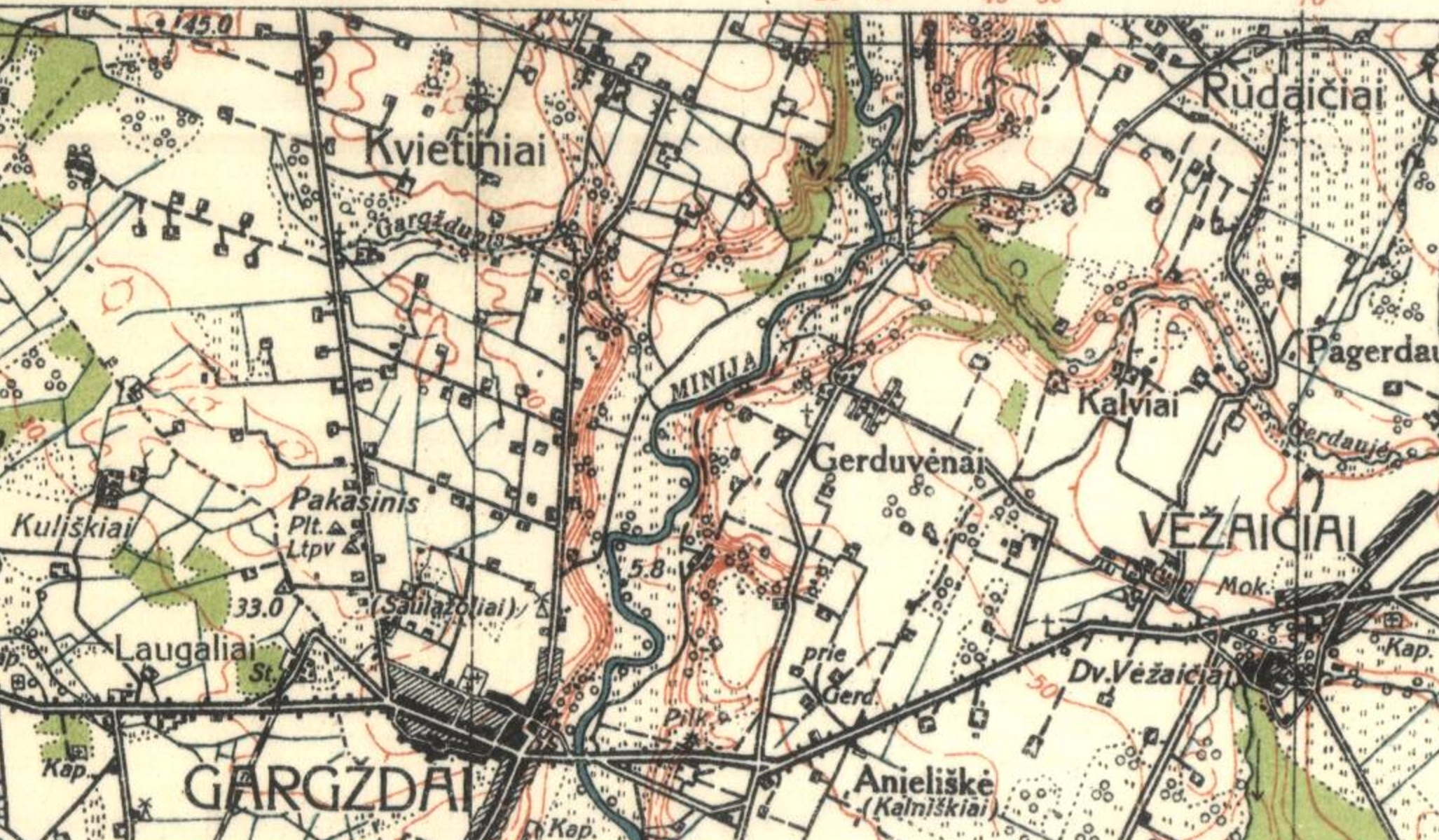

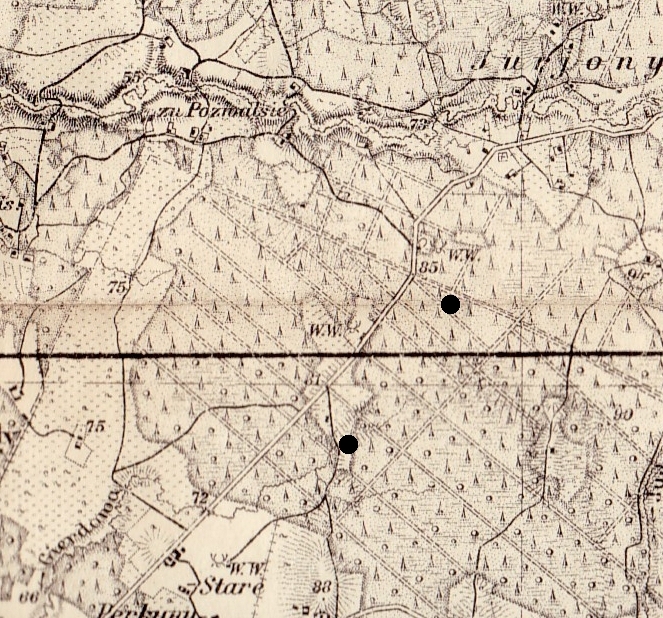
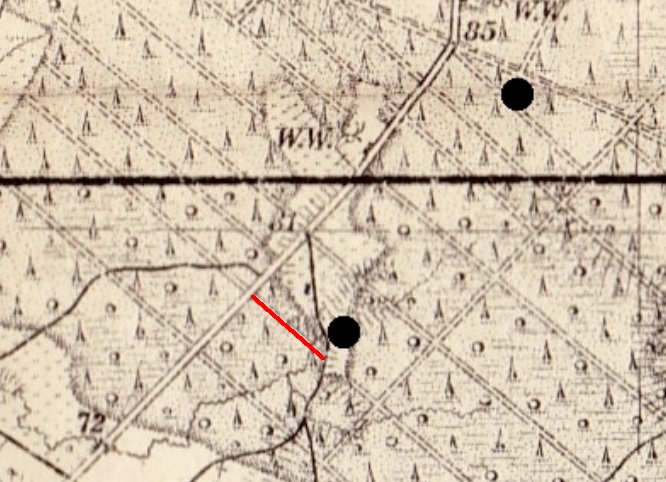

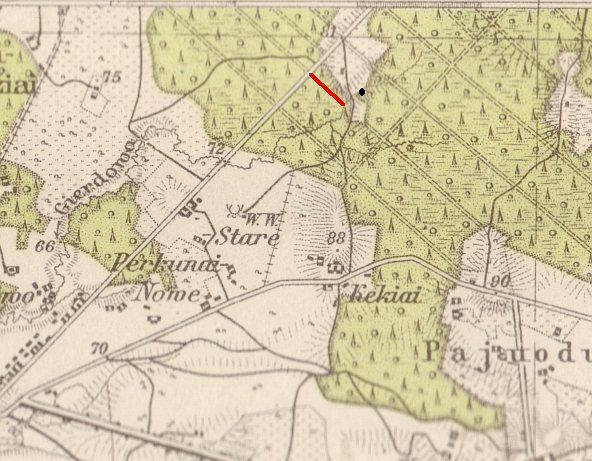
The distances as testified to
by Puzneckis may be compared with the following
somewhat older map, with superimposed meter scale
from the same map. Using the Google Earth
measuring tool, the distance from the possible
turning point to the location of the cluster of
buildings marked Asmoniske on the Lithuanian
topographical map, is approximately 850 meters.
The approximate one kilometer distance testified
to by Puzneckis would be a reasonable estimate.
Further, the distance from the road turnoff,
measured along the forest road to the end of the
forested area, is consistent with the half
kilometer distance testified by Puzneckis. The
length of the red line below measured on Google
Earth is approximately 400 meters. To view
this road on various maps, see the animations at vezaitine
comparison.
Gubistas also estimated the distance from the turnoff point to the first day's killing site as 500 meters. See note 24.
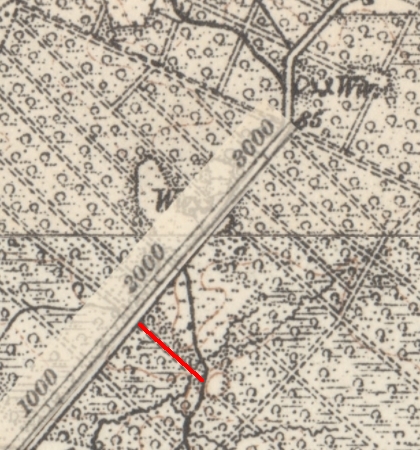
Road marked in red, if it existed in 1941, would best fit Puzneckis testimony that the carts turned 1km south of Ashmoniske, traveled 500m down a forest road, and then stopped by a meadow. This road appears on virtually all historical maps except the Lithuanian Army topological map of 1938-39, and a remnant may be visible in satellite photos today. See Photo/Map Comparison of Vezaitine Forest.
Explanation of map symbols:
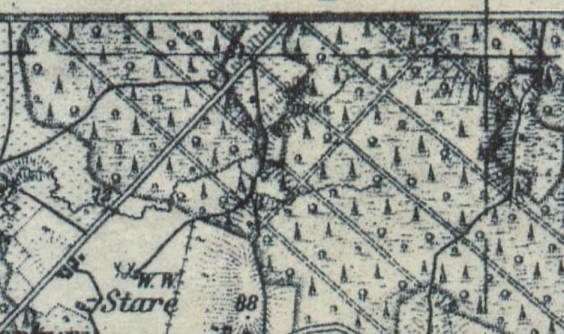



Another possible location for the route testified to by Puzneckis
may be a path currently shown on maps.lt.
This path is located near the dotted line boundary extending southeast
from the road, shown on the Lithuanian military topographic map 1301
(1938 - 1939). This boundary is marked by the yellow arrow below:
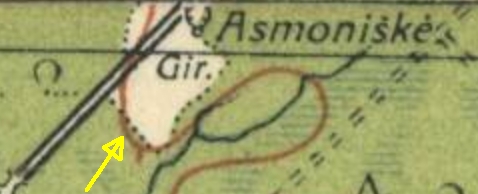
Efraim Zuroff, Operation
Last Chance: One Man's Quest to Bring Nazi
Criminals to Justice pp. 157-158 states
Lukauskas was from Rudaiciai. There are two
towns with this name, one northwest of Kretinga
(Map #1200)
and the other north of Vezaiciai (Map #1300).
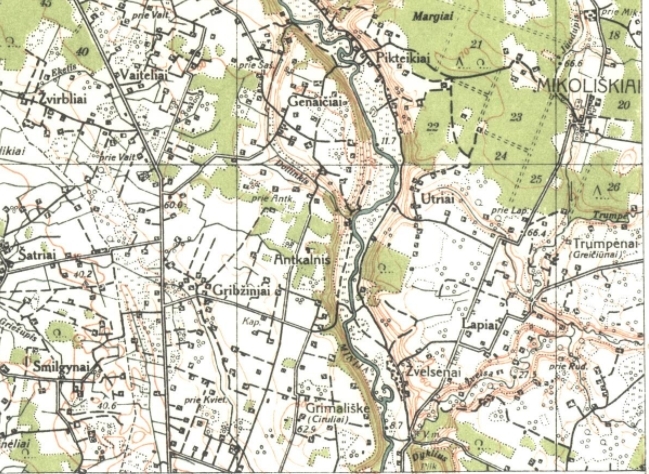
A need to divide the victims into two groups likely arose due to a lack of sufficient transportation to take all the victims to a killing site on the same day. The Lithuanian cart drivers requisitioned to provide transportation had to take multiple trips on a single day. www.yahadinunum.org/lithuanitrip-4-october-8-23-2014
23 The forest is usually called the
Vezaitine Forest, evidently named for the nearby town of Vezaiciai to
the southwest. The alternative name for the forest used by this
Defendant may be based upon the town of Zvelsenai, to the west of the
forest (see map preceding Note 1), or the stream Zvelsa, which is a
tributary to the Minija River running immediately north of the forest
(see Lithuanian Topographic Map following Note 5).
24 The site of the first killings would
be the northeasterly of the two sites in the forest, if Puzneckis was
correct that the second site was reached by turning into the woods south
of Asmoniske. However other evidence indicates Puzneckis likely confused
the two sites, and the first day's killings were at the southwest site.
Gubistas specifically indicates he is talking about the first day's
killings. Like Puzneckis, he estimates the distance from the road to the
killing site at 500 meters. See Note 9.
25 This individual was also identified
as a perpetrator by Saliklas.
26 See interrogation of Puzneckis. His
place of residence was evidently Saulazoliai. See Note
4.
27 See Note 8. The
other witnesses disagree as to whether Mockus was at the first shooting.
He was not listed by Saliklis as present at the first killings.
Puzneckis stated that Gargzdai police chief "Manchkus" was at both
shootings.
28 See Interrrogation minutes of
Saliklis.
29 See Note 12.
30 Possibly Straigiai, east of Lazdijai.
31 Evidently Mizuikai, east of Kuliai.
The "Reistenes" forest is unidentified.
32 Possibly Veivirzenai, southeast
of Gargzdai.
33Unidentifed.
34Possibly Endriejavas.
35This is the only reference to alcohol
in the three Soviet interrogations. The Ulm judgment had referenced
statements attributing the killings to "betrunkene litauische
Hilfspolizisten" (drunken Lithuanian auxiliary police). KZ-Verbrechen
vor deutschen Gerichten, Band II: Einsatzkommando Tilsit - Der Prozess
zu Ulm (Frankfurt am Mein: Europaïsche Verlagsanstalt, 1966), p. 401. On
the role of alcohol in similar killings, see Nestar Russell, Operation
Barbarossa and the Holocaust by Bullets - Bottom-Up Forces, https://link.springer.com/chapter/10.1007/978-3-319-97999-1_5
This page was updated
October 1, 2020.
Copyright © 2017-2020 John S. Jaffer